Rivet: Difference between revisions
→Sizes: one ref. Consider removing rest unless there's sources. |
→Sizes: one ref. Consider removing rest unless there's sources. |
||
| Line 158: | Line 158: | ||
{{Globalize|date=September 2010}} |
{{Globalize|date=September 2010}} |
||
[[File:M3 tank riveting LOC fsa 8e10699.jpg|thumb|Installing rivets on [[M3 Lee|M3 tank]] hull]] |
[[File:M3 tank riveting LOC fsa 8e10699.jpg|thumb|Installing rivets on [[M3 Lee|M3 tank]] hull]] |
||
Rivet diameters are commonly measured in {{frac|32}}-inch increments<ref>http://machinedesign.com/article/straight-facts-on-blind-rivets-0316</ref> and their lengths in {{frac|16}}-inch increments, expressed as "dash numbers" at the end of the rivet identification number. A "dash 3 dash 4" (XXXXXX-3-4) designation indicates a {{frac|3|32}}-inch diameter and {{frac|4|16}}-inch (or {{frac|1|4}}-inch) length. Some rivets lengths are also available in "half sizes" and will have a dash number such as –3.5 ({{frac|7|32}} inch) to indicate that it is a half-size rivet. The letters and digits in a rivet's identification number that precede its dash numbers indicate the specification under which the rivet was manufactured and the head style. On many rivets, a size in 32nds may be stamped on the rivet head. Other makings on the rivet head, such as small raised or depressed dimples or small raised bars indicate the rivet's alloy. |
|||
To become a proper fastener, a rivet should be placed in hole ideally 4–6 thousandths of an inch larger in diameter. This allows the rivet to be easily and fully inserted, then setting allows the rivet to expand, tightly filling the gap and maximizing strength. |
To become a proper fastener, a rivet should be placed in hole ideally 4–6 thousandths of an inch larger in diameter. This allows the rivet to be easily and fully inserted, then setting allows the rivet to expand, tightly filling the gap and maximizing strength. |
||
Revision as of 07:11, 10 September 2012


A rivet is a permanent mechanical fastener. Before being installed a rivet consists of a smooth cylindrical shaft with a head on one end. The end opposite the head is called the buck-tail. On installation the rivet is placed in a punched or drilled hole, and the tail is upset, or bucked (i.e., deformed), so that it expands to about 1.5 times the original shaft diameter, holding the rivet in place. To distinguish between the two ends of the rivet, the original head is called the factory head and the deformed end is called the shop head or buck-tail.
Because there is effectively a head on each end of an installed rivet, it can support tension loads (loads parallel to the axis of the shaft); however, it is much more capable of supporting shear loads (loads perpendicular to the axis of the shaft). Bolts and screws are better suited for tension applications.
Fastenings used in traditional wooden boat building, like copper nails and clinch bolts, work on the same principle as the rivet but were in use long before the term rivet came about and, where they are remembered, are usually classified among the nails and bolts respectively.
Types
There are a number of types of rivets, designed to meet different cost, accessibility, and strength requirements:
Solid rivets
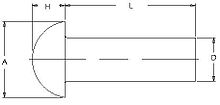
Solid rivets are one of the oldest and most reliable types of fasteners, having been found in archaeological findings dating back to the Bronze Age. Solid rivets consist simply of a shaft and head which are deformed with a hammer or rivet gun. The use of a rivet compression or crimping tool can also be used to deform this type of rivet; this tool is mainly used on rivets close to the edge of the fastened material, since the tool is limited by the depth of its frame. A rivet compression tool does not require two people and is generally the most foolproof way to install solid rivets.
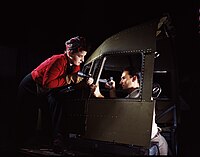
Solid rivets are used in applications where reliability and safety count. A typical application for solid rivets can be found within the structural parts of aircraft. Hundreds of thousands of solid rivets are used to assemble the frame of a modern aircraft. Such rivets come with rounded (universal) or 100° countersunk heads. Typical materials for aircraft rivets are aluminium alloys (2017, 2024, 2117, 7050, 5056, 55000, V-65), titanium, and nickel-based alloys (e.g. Monel). Some aluminum alloy rivets are too hard to buck and must be softened by annealing prior to being bucked. "Ice box" aluminum alloy rivets harden with age, and must likewise be annealed and then kept at sub-freezing temperatures (hence the name "ice box") to slow the age-hardening process. Steel rivets can be found in static structures such as bridges, cranes, and building frames.
The setting of these fasteners requires access to both sides of a structure. Solid rivets are driven using a hydraulically, pneumatically, or electromagnetically driven squeezing tool or even a handheld hammer. Applications in which only one side is accessible require the use of blind rivets.
High strength structural steel rivets
Until relatively recently, structural steel connections were either welded or riveted. High-strength bolts have completely replaced structural steel rivets. Indeed, the latest steel construction specifications published by AISC (the 13th Edition) no longer covers their installation. The reason for the change is primarily due to the expense of skilled workers required to install high strength structural steel rivets. Whereas two relatively unskilled workers can install and tighten high strength bolts, it took a minimum of four highly skilled riveters to install rivets in one joint at a time.[citation needed]
At a central location near the areas being riveted, a furnace was set up. Rivets were placed in the furnace and heated to a glowing hot temperature, at which time the furnace operator would use tongs to individually remove and throw them to catchers stationed near the joints to be riveted. The catcher would place the glowing hot rivet into the hole to be riveted, and quickly turn around to await the next rivet. One worker would then hold a heavy rivet set, also called a 'dolly' against the round head of the rivet, while the hammerer would apply a pneumatic rivet hammer to the unformed head, causing it to mushroom tightly against the joint in its final domed shape. Upon cooling, the rivet would contract and exert further force tightening the joint. This process was repeated for each rivet.
The last commonly used high strength structural steel rivets were designated ASTM A502 Grade 1 rivets.[1]
Such riveted structures may be insufficient to resist seismic loading from earthquakes if the structure was not engineered for such forces, a common problem of older steel bridges. This is due to the fact that a hot rivet cannot be properly heat treated to add strength and hardness. In the seismic retrofit of such structures it is common practice to remove critical rivets with an oxygen torch, precision ream the hole, and then insert a machined and heat treated bolt.
Semi-tubular rivets

Semi-tubular rivets (also known as tubular rivets) are similar to solid rivets, except they have a partial hole (opposite the head) at the tip. The purpose of this hole is to reduce the amount of force needed for application by rolling the tubular portion outward. The force needed to apply a semitubular rivet is about 1/4 of the amount needed to apply a solid rivet. Tubular rivets can also be used as pivot points (a joint where movement is preferred) since the swelling of the rivet is only at the tail. Solid rivets expand radially and generally fill the hole limiting movement. The type of equipment used to apply semi-tubular rivets range from prototyping tools (less than $50) to fully automated systems. Typical installation tools (from lowest to highest price) are hand set, manual squeezer, pneumatic squeezer, kick press, impact riveter, and finally PLC-controlled robotics. The most common machine is the impact riveter and the most common use of semitubular rivets is in lighting, brakes, ladders, binders, HVAC duct work, mechanical products, and electronics. They are offered from 1/16-inch (1.6 mm) to 3/8-inch (9.5 mm) in diameter (other sizes are considered highly special) and can be up to 8 inches (203 mm) long. A wide variety of materials and platings are available, most common base metals are steel, brass, copper, stainless, aluminum and most common platings are zinc, nickel, brass, tin. All tubular rivets are waxed to facilitate proper assembly. The finished look of a tubular rivet will have a head on one side, with a rolled over and exposed shallow blind hole on the other. Semi-tubular rivets are the fastest way to rivet in mass production but require a capital investment.
Blind rivets

Blind rivets, commonly referred to as pop rivets, (POP is the registered brand name of the original blind rivet manufacturer owned by Emhart Teknologies) are tubular and are supplied with a mandrel through the center. The rivet assembly is inserted into a hole drilled through the parts to be joined and a specially designed tool is used to draw the mandrel into the rivet. This expands the blind end of the rivet and then the mandrel snaps off. These types of blind rivets have non-locking mandrels and are sometimes avoided for critical structural joints because the mandrels may fall out, due to vibration or other reasons, leaving a hollow rivet that will have a significantly lower load carrying capability than solid rivets. Furthermore, because of the mandrel they are more prone to failure from corrosion and vibration. Unlike solid rivets, blind rivets can be inserted and fully installed in a joint from only one side of a part or structure, "blind" to the opposite side.[2]
Prior to the adoption of blind rivets, installation of a solid rivet typically required access to both sides of the assembly: a rivet hammer on one side and a bucking bar on the other side. In 1916 Royal Navy reservist and engineer Hamilton Neil Wylie filed a patent for an "improved means of closing tubular rivets" (granted May 1917).[3] In 1922 Wylie joined the British aircraft manufacturer Armstrong-Whitworth Ltd to advise on metal construction techniques; here he continued to develop his rivet design with a further 1927 patent[4] that incorporated the pull through mandrel, and allowed the rivet to be used 'blind'. By 1928 the George Tucker Eyelet company were producing a 'cup' rivet based on the design which required a separate GKN mandrel and the rivet body to be hand assembled prior to use for the building of the Siskin III aircraft. Together with Armstrong-Whitworth, the Geo. Tucker Co. further modified the rivet design to produce a one piece unit incorporating mandrel and rivet.[5] This product was later developed in Aluminium and trademarked as the 'POP' rivet. The United Shoe Machinery Co. produced the design in the US as inventors such as Carl Cherry and Lou Huck experimented with other techniques for expanding solid rivets.
Due to this feature, blind rivets are mainly used when access to the joint is only available from one side. The rivet is placed in a drilled hole and is set by pulling the mandrel head into the rivet body, expanding the rivet body and causing it to flare against the reverse side. As the head of the mandrel reaches the face of the blind side material, the pulling force is resisted, and at a predetermined force, the mandrel will snap at its break point, also called "Blind Setting". A tight joint formed by the rivet body remains, the head of the mandrel remains encapsulated at the blind side, although variations of this are available, and the mandrel stem is ejected.
They are available in flat head, countersunk head, and modified flush head with standard diameters of 1/8, 5/32 and 3/16 inch. Blind rivets are made from soft aluminum alloy, steel (including stainless steel), copper, and Monel.
There are also structural blind rivet, which are designed to take shear and tensile loads.[6]
The rivet body is normally manufactured using one of three methods:
| Name | Description |
|---|---|
| Wire | the most common method |
| Tube | common in longer lengths, not normally as strong as wire |
| Sheet | least popular and generally the weakest option |
There is a vast array of specialty blind rivets that are suited for high strength or plastic applications. Typical types include:
| Name | Description |
|---|---|
| TriFold | a rivet that splits into three equal legs like a molly bolt. Typically used in soft plastics where a wide footprint is needed at the rear surface. Used in automotive interiors and vinyl fences. |
| Structural rivet(a) | an "external" mechanically locked structural blind rivet that is used where a watertight, vibration resistant connection is of importance. Typically used in manufacture or repair of truck bodies. A special nose piece is required to apply this rivet. |
| Structural rivet(b) | an "internal" mechanically locked structural blind rivet that is used where a watertight, vibration resistant connection is of importance. Typically used in manufacture or repair of truck bodies. |
Internally and externally locked structural blind rivets can be used in aircraft applications because, unlike other types of blind rivets, the locked mandrels cannot fall out and are water tight. Since the mandrel is locked into place they have the same or greater load carrying capacity as solid rivets and may be used to replace solid rivets on all but the most critical stressed aircraft structures.
The typical assembly process requires the operator to install the rivet in the nose of the tool by hand then actuate the tool. However, in recent years automated riveting systems have become popular in an effort to reduce assembly costs and repetitive disorders. The cost of such tools range from US$1,500 for autofeed pneumatics to US$50,000 for fully robotic systems.
Drive rivet
A drive rivet is a form of blind rivet that has a short mandrel protruding from the head that is driven in with a hammer to flare out the end inserted in the hole. This is commonly used to rivet wood panels into place since the hole does not need to be drilled all the way through the panel, producing an aesthetically pleasing appearance. They can also be used with plastic, metal, and other materials and require no special setting tool other than a hammer and possibly a backing block (steel or some other dense material) placed behind the location of the rivet while hammering it into place. Drive rivets have less clamping force than most other rivets.
Flush rivet
A flush rivet is used primarily on external metal surfaces where good appearance and the elimination of unnecessary aerodynamic drag are important. A flush rivet takes advantage of a countersink hole, they are also commonly referred to as countersunk rivets. Countersunk or flush rivets are used extensively on the exterior of aircraft for aerodynamic reasons. Additional post-installation machining may be performed to perfect the airflow.
Friction-lock rivet
One early form of blind rivet that was the first to be widely used for aircraft construction and repair was the Cherry friction-lock rivet. Originally, Cherry friction-locks were available in two styles, hollow shank pull-through and self-plugging types. The pull-through type is no longer common, however, the self -plugging Cherry friction-lock rivet is still used for repairing light aircraft.
Cherry friction-lock rivets are available in two head styles, universal and 100 degree countersunk. Furthermore, they are usually supplied in three standard diameters, 1/8, 5/32 and 3/16 inch.
A friction-lock rivet cannot replace a solid shank rivet, size for size. When a friction-lock is used to replace a solid shank rivet, it must be at least one size larger in diameter because the friction-lock rivet loses considerable strength if its center stem falls out due to vibrations or damage.
Rivet alloys, their shear strengths and condition in which they are driven.
| Alloy type | Alphabetical letter | Driven condition | Marking on head |
|---|---|---|---|
| 1100 | A | 1100-F | PLAIN |
| 2117 | AD | 2117T3 | DIMPLE |
| 5056 | B | 5056H32 | RAISED CROSS |
| 2017 | D | 2017T31 | RAISED DOT |
| 2024 | DD | 2024T31 | TWO RAISED DASHES |
| 7050 | E | 7050T73 | RAISED RING |
Self-pierce rivets
Self-pierce riveting (SPR) is a process of joining two or more materials using an engineered rivet. Unlike solid, blind and semi-tubular rivets, self-pierce rivets do not require a drilled or punched hole.
SPRs are cold forged to a semi-tubular shape and contain a partial hole to the opposite end of the head. The end geometry of the rivet has a chamfered poke which aids the piercing of the materials being joined, a hydraulic or electric servo rivet setter drives the rivet into the material and an upsetting die provides a cavity for the displaced bottom sheet material to flow.
The self-pierce rivet fully pierces the top sheet material(s) but only partially pierces the bottom sheet. As the tail end of the rivet does not break through the bottom sheet it provides a water or gas tight joint. With the influence of the upsetting die, the tail end of the rivet flares and interlocks into the bottom sheet forming a low profile button.
Rivets need to be harder than the materials being joined, they are heat treated to various levels of hardness depending on the materials ductility and hardness. Rivets come in a range of diameters and lengths depending on the materials being joined, head styles are either flush countersunk or pan heads.
Depending on the rivet setter configuration, i.e. hydraulic, servo, stroke, nose-to-die gap, feed system etc., cycle times can be as quick as one second. Rivets are typically fed to the rivet setter nose from tape and come in cassette or spool form for continuous production.
Riveting systems can be manual or automated depending on the application requirements; all systems are very flexible in terms of product design and ease of integration into a manufacturing process.
SPR joins a range of dissimilar materials such as steel, aluminum, plastics, composites and pre-coated or pre-painted materials. Benefits include low energy demands, no heat, fumes, sparks or waste and very repeatable quality.
Sizes
The examples and perspective in this article may not represent a worldwide view of the subject. (September 2010) |
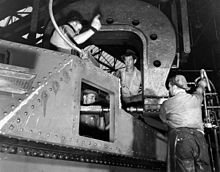
Rivet diameters are commonly measured in 1⁄32-inch increments[7] and their lengths in 1⁄16-inch increments, expressed as "dash numbers" at the end of the rivet identification number. A "dash 3 dash 4" (XXXXXX-3-4) designation indicates a 3⁄32-inch diameter and 4⁄16-inch (or 1⁄4-inch) length. Some rivets lengths are also available in "half sizes" and will have a dash number such as –3.5 (7⁄32 inch) to indicate that it is a half-size rivet. The letters and digits in a rivet's identification number that precede its dash numbers indicate the specification under which the rivet was manufactured and the head style. On many rivets, a size in 32nds may be stamped on the rivet head. Other makings on the rivet head, such as small raised or depressed dimples or small raised bars indicate the rivet's alloy.
To become a proper fastener, a rivet should be placed in hole ideally 4–6 thousandths of an inch larger in diameter. This allows the rivet to be easily and fully inserted, then setting allows the rivet to expand, tightly filling the gap and maximizing strength.
Applications

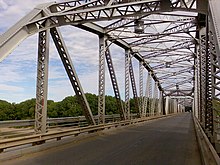


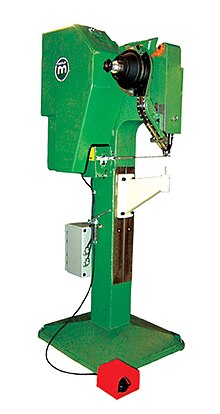
Before welding techniques and bolted joints were developed, metal framed buildings and structures such as the Eiffel Tower, Shukhov Tower and the Sydney Harbour Bridge were generally held together by riveting. Also automobile chassis were riveted. Riveting is still widely used in applications where light weight and high strength are critical, such as in an aircraft. Many sheet-metal alloys are preferably not welded as deformation and modification of material properties can occur.
Blind rivets are used almost universally in the construction of plywood road cases.
Common but more exotic uses of rivets are to reinforce jeans and to produce the distinctive sound of a sizzle cymbal.
Joint analysis
The stress and shear in a rivet is analyzed like a bolted joint. However, it is not wise to combine rivets with bolts and screws in the same joint. Rivets fill the hole where they are installed to establish a very tight fit (often called interference fit). It is difficult or impossible to obtain such a tight fit with other fasteners. The result is that rivets in the same joint with loose fasteners will carry more of the load—they are effectively more stiff. The rivet can then fail before it can redistribute load to the other loose fit fasteners like bolts and screws. This often results in catastrophic failure of the joint when the fasteners "unzip". In general, a joint composed of similar fasteners is the most efficient because all fasteners will reach capacity simultaneously.
Installation
Solid & semi tubular rivets
There are several methods for installing solid rivets.
- Manual with hammer and handset or bucking bar
- Pneumatic Hammers
- Handheld Squeezers
- Riveting machines
- Pin Hammer, Rivet Set
Rivets that are small enough and soft enough are often "bucked".[8] In this process the installer places a rivet gun against the factory head and holds a bucking bar against the tail or a hard working surface. The bucking bar is a specially shaped solid block of metal. The rivet gun provides a series of high-impulse forces that upset the rivet in place. Rivets that are large or hard may be more easily installed by squeezing instead. In this process a tool in contact with each end of the rivet clinches to deform the rivet.
Rivets may also be upset by hand, using a ball-peen hammer. The head is placed in a special hole made to accommodate it, known as a rivet-set. The hammer is applied to the buck-tail of the rivet, rolling an edge so that it is flush against the fastened material.
Testing
Solid rivets for construction
A hammer is also used to "ring" an installed rivet, as a non-destructive test for tightness and imperfections. The inspector taps the head (usually the factory head) of the rivet with the hammer while touching the rivet and base plate lightly with the other hand and judges the quality of the audibly returned sound and the feel of the sound traveling through the metal to the operator's fingers. A rivet tightly set in its hole will return a clean and clear ring, while a loose rivet will return a recognizably different sound.
Testing of blind rivets
A blind rivet has strength properties that can be measured in terms of shear and tensile strength. Occasionally rivets also undergo performance testing for other critical features, such as pushout force, break load and salt spray resistance. A standardized destructive test according to the Inch Fastener Standards is widely accepted[9][10]
The shear test involves installing a rivet into two plates at specified hardness and thickness and measuring the force necessary to shear the plates. The tensile test is basically the same, except that it measures the pullout strength. Per the IFI-135 standard, all blind rivets produced must meet this standard. These tests determine the strength of the rivet, and not the strength of the assembly. To determine the strength of the assembly a user must consult an engineering guide or the Machinery's Handbook[11]
Alternatives
See also
References
- ^ Segui, William T. (2007). Steel Design (4th ed.). Toronto: Thomson. ISBN 0-495-24471-6.
- ^ Blind Rivets, August 1942, Popular Science early article that explains how they work
- ^ Improved means of closing tubular rivets. - United Kingdom Patent GB106169
- ^ Improvements in and relating to rivets and riveting - United Kingdom Patent GB286471
- ^ Emhart News June 2011 GB
- ^ Smith 1990, p. 159.
- ^ http://machinedesign.com/article/straight-facts-on-blind-rivets-0316
- ^ The term "bucked" comes from a name for one of the two parts of a rivet. The "head" of the rivet is one part, and is the part that the air-hammer strikes. The other part is referred to as the "bucktail", and is the part that the bucking bar is held against. Hence the terms "bucking bar", "bucked", and "buck-man"
- ^ "Industrial Fasteners Institute". Industrial-fasteners.org. Retrieved 2012-04-28.
- ^ IFI, Industrial Fasteners Institure (2003). Inch Fastener Standards (7th ed.). Industrial Fasteners Institure: Industrial Fasteners Institure. ISBN unknown.
{{cite book}}: Check|isbn=value: invalid character (help) - ^ Heald, Oberg, Jones, Ryffel, McCauley and Heald (2008). Machinery's Handbook (28th ed.). Industrial Press: Industrial Press. ISBN 0-8311-2828-3.
{{cite book}}: CS1 maint: multiple names: authors list (link)
Bibliography
- Smith, Carroll (1990). Carroll Smith's Nuts, Bolts, Fasteners, and Plumbing Handbook. MotorBooks/MBI Publishing Company. p. 112. ISBN 0-87938-406-9.
{{cite book}}: Invalid|ref=harv(help)
External links
select an article title from: Wikisource:1911 Encyclopædia Britannica
- Popular Science, November 1941, Self-Setting Explosive Rivet Speeds Warplane Building system used by both the US and Germany in World War Two for aircraft assembly - see bottom half of page
- "Four Methods of Flush Riveting" film made by Disney Studios during World War Two
- "Hold Everything", February 1946, Popular Science new rivet types developed during World War Two
- "Blind Rivets they get it all together. Popular Science, October 1975, pp. 126-128.
